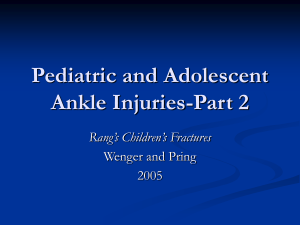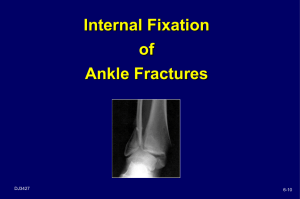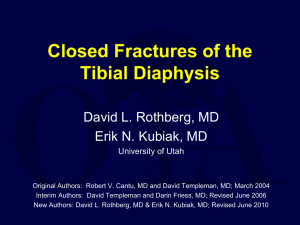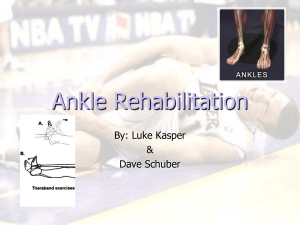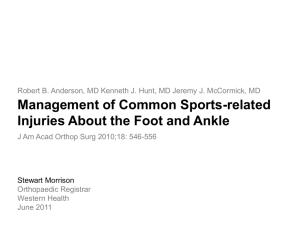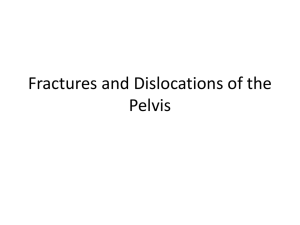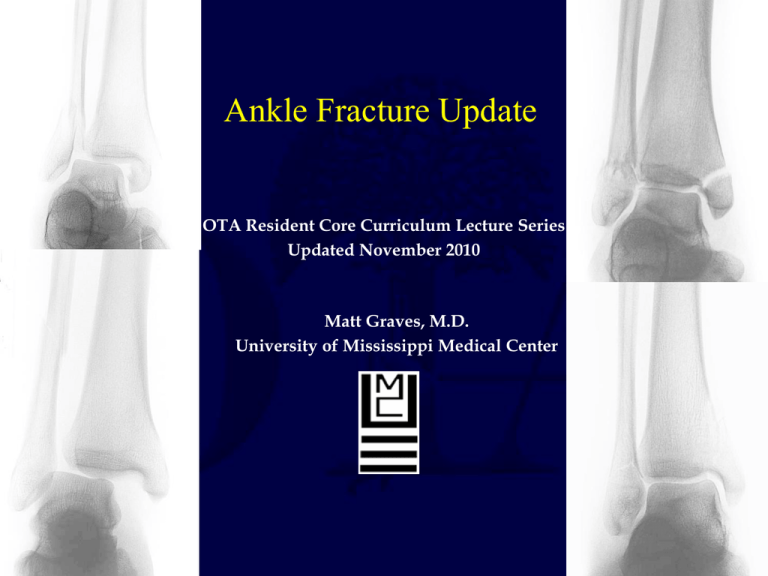
Ankle Fracture Update
OTA Resident Core Curriculum Lecture Series
Updated November 2010
Matt Graves, M.D.
University of Mississippi Medical Center
Objectives
Following this session, you should be able to:
1.State the indication to fix isolated fibular
fractures.
2.Define the specific articular pathology
associated with SA and PAB fractures.
3.List the 3 common posterior malleolar
fracture patterns.
4.State the indication to fix posterior malleolar
fractures.
1.Enumerate the ways to ensure syndesmotic
reduction.
Recommendations to Improve
Retention of this Material
1. Write down the objectives
2. Search for the answers to the objectives in the powerpoint
talk [hint- look for blue boxes]
3. Test yourself at the end by reviewing the objectives
4. Watch the show on “normal view” and look at the notes at the
bottom of the slides. They will provide guidance to the
progression of logic and sources of information. Classic
references are listed throughout. Annotated recent references
are listed at the end.
Outline
•Evaluation: Clinical & Radiographic
•Classification: Lauge-Hansen
•Specific Problem Areas: Posterior
Malleolus and Syndesmosis
•Surgical Goals
•Outcome
Evaluation:
Clinical
HISTORY
PHYSICAL EXAM
Mechanism
Skin
Timing
Nerves
Soft-tissue injury
Vasculature
Bone quality
Pain
Comorbidities
Deformity
Associated Injuries
Evaluation: Radiographic
Anteroposterior View
– Tibiofibular overlap ~ 10mm
– Tibiofibular clear space <5mm
– Talar tilt
Comparison Radiograph?
Evaluation: Radiographic
Mortise View
10 degrees internal rotation of 5th MT with respect to a vertical line
Goergen JBJS 1977
Evaluation: Radiographic
Mortise View
– Medial joint space
– Talocrural angle: <8 or >15
degrees
– Tibia/fibula overlap:>1mm
Comparison Radiograph?
Evaluation: Radiographic
Mortise View
FIBULAR LENGTH: 1. Shenton’s Line of the ankle
2. The dime test
Weber SICOT 1981
Evaluation: Radiographic
Lateral View
PM
Talar subluxation
Distal fibular translation &/or angulation
Syndesmotic relationship
Associated or occult injuries
– Lateral process talus
– Posterior process talus
– Anterior process calcaneus
Evaluation: Radiographic
Other Imaging Modalities
Stress Views
–
–
Gravity
Manual
CT
–
–
Articular involvement
Posterior malleolus
MRI
–
Ligament and tendon injury
–
Talar dome lesions
–
Syndesmosis injuries
Outline
•Evaluation: Clinical &
Radiographic
•Classification: Lauge-Hansen
•Specific Problem Areas: Posterior
Malleolus and Syndesmosis
•Surgical Goals
•Outcome
Lauge-Hansen
Cadaveric study
First word: position of foot at time of injury
Second word: force applied to foot relative to tibia at time of injury
Types:
SER
SA
PER
PA
Lauge-Hansen
Several stages per type
Imperfect system:
– Not every fracture fits exactly into one category
– Even mechanismspecific pattern has been questioned
– Inter and intraobserver variation not ideal
– Still useful and widely used
Supination-External Rotation
Stage 1- AITFL
Stage 2- Fibula fx
Stage 3- PITFL or
PM fx
Stage 4-Deltoid or
MM fx
70% of ankle fractures
Stage 2 Supination-External Rotation
Stage 2: Stable
Lateral Injury: classic posterosuperioranteroinferior fibula fracture
Medial Injury: Stability maintained
Standard: Closed management
Kristensen Acta Orthop Scand 1985
Stage 4
Supination-External Rotation
Stage 4: Unstable
Lateral Injury: classic posterosuperioranteroinferior fibula fracture
Medial Injury: medial malleolar fracture &*/or deltoid ligament injury
Standard: Surgical management
*Tornetta JBJS 2000
SER-2 vs SER-4: How to
Decide?
Michelson. Clin Orthop Rel Res 2001
GOAL: TO EVALUATE
DEEP
DELTOID
[i.e.2003
INSTABILITY]
DeAngelis
Poster
OTA
Tornetta. Poster AAOS 2004
MEDIAL TENDERNESS
METHOD:
McConnell JBJS 2004
MEDIAL
Egol SWELLING
JBJS 2004
MEDIAL
ECCHYMOSIS
Schock
Presentation
OTA 2006
Zeni Presentation
OTA
STRESS
VIEWS- GRAVITY
OR2006
MANUAL
Park J Orthop Trauma 2006
Gravity Stress Exam
Michelson et al. CORR 387: 178-82, 2001.
Manual Stress
Exam
versus
•Both are effective
•Gravity stress requires XR education.
•Manual stress requires time and more radiation exposure.
Schock et al. JBJS 89B: 1055-59, 2007.
SER-2 vs. SER-4: How To Decide?
Indication to fix isolated fibular fractures
Decision-Tree:
Understand the Logic
Assumptions:
1. Fibular fractures associated with a stable ankle
mortise heal without significant functional
consequence.
2. Fibular fractures associated with an unstable
ankle mortise heal with significant functional
problems…because instability allows for talar
shift.
Decision Tree:
Understand the Logic
Stress View
Splintage
Decision-Tree:
Understand the Logic
Does a Positive Ankle Stress Test Indicate the
Need for Operative Treatment?
– MRI to evaluate all patients with lateral malleolar
fracture and positive stress test (n=21).
– If deep deltoid partially intact nonop treatment
– Good clinical outcomes.
OTA Annual Meeting. Foot & Ankle Section. Paper #24, 2006.
Indication to fix isolated fibular fractures
Choose a technique
to evaluate
stability. Base
your decision to
operate on your
findings and the
risk:benefit ratio.
Supination Adduction
Stage 1: transverse Weber A or
B fibula
Stage 2: vertical medial
malleolus
Supination Adduction: Stage 2
Lateral Injury: transverse fibular fracture at/below level of mortise
Medial injury: vertical shear type medial malleolar fracture
BEWARE OF IMPACTION
McConnell J Orthop Trauma 2001
Supination Adduction: Stage 2
Important to restore:
– Ankle stability
– Articular congruency- including medial
impaction
SAD
Consider anteromedial
approach
Marginal impaction
reduction +/- grafting
Medial antiglide plate
Specific articular pathology associated with SA
Pronation-External Rotation
Stage 1 - deltoid or medial
malleolus
Stage 2- AITFL and IO
membrane
Stage 3 – spiral Weber C
fibula
Stage 4 – PITFL or posterior
malleolus
Pronation External Rotation:
Stage 4
Medial injury: deltoid ligament tear &/or transverse medial malleolar fracture
Lateral Injury: spiral proximal lateral malleolar fracture
HIGHLY UNSTABLE…SYNDESMOTIC INJURY COMMON
PER
Tibia radiograph
Syndesmostic disruption expected
Restore:
– Fibular length and rotation
– Ankle mortise
– Syndesmotic stability
Pronation-Abduction
Stage 1 – transverse MM
Stage 2 – PITFL or PM
fracture
Stage 3 – compression
bending fibula fracture
Pronation-Abduction
Medial injury: tranverse to short oblique medial malleolar fracture
Lateral Injury: comminuted impaction type lateral malleolar fracture
PAB
Medial malleolar fixation drives stability. Go there 1st.
Fibular comminution length stable construct?
Stress the syndesmosis last
JBJS 89A: 276-81, 2007
PAB
Specific articular pathology associated with PAB
PAB:
Specific Articular Pathology
Outline
•Evaluation: Clinical & Radiographic
•Classification: Lauge-Hansen
•Specific Problem Areas: Posterior
Malleolus and Syndesmosis
•Surgical Indications and Goals
•Outcome
Posterior Malleolus Fractures
Function:
Stability- prevents posterior translation of talus &
enhances syndesmotic stability
Weight bearing- increases surface area of ankle joint
Posterior Malleolus Fractures:
Radiographic Evaluation
Fracture pattern:
– Variable
– Difficult to assess on standard lateral radiograph
• External rotation lateral view [Decoster FAI 2000]
• CT scan [Haraguchi JBJS 2006]
Posterior Malleolus Fracture:
Radiographic Evaluation
Indication for fixation: > 25% joint surface on lateral
Problem: Fragment size hard to determine on lateral view
– Reason: Fracture orientation not purely in coronal plane
• Nearly always associated with the pull of the posterior tib-fib ligament
– larger laterally than medially
– obliquely oriented
– involves the incisura
Haraguchi et al. JBJS 2006
…but other fracture patterns have also been defined
Posterior Malleolus Fracture
67%
19%
Type I- posterolateral oblique type
Type II- medial extension type
14%
Type III- small shell type
3 common PM fracture patterns
Haraguchi et al. JBJS 2006
Posterior Malleolus Fractures:
Indications for Fixation
Stability
– Posterior translation of talus*
– ER of talus [syndesmotic widening]
Articular congruence
– Stress = Force/Area
– Excessive stressposttraumatic arthritis
• Maximize area for stress distribution**
*fibula and anterior tibiofibular ligament act as primary restraint [Raasch JBJS 1992]
**contact stress changes significantly with posterior malleolar size >33% [Hartford CORR 1995]
Posterior Malleolus Fracture: Fixation
Screws
Plates
Syndesmotic Injury
FUNCTION:
Stability- resists external rotation, axial, & lateral
displacement of talus
Weight bearing- allows for standard loading
Syndesmosis
IF INSTABILITY PRESENT OPERATIVE INTERVENTION
OBTAINING & MAINTAINING ANATOMIC REDUCTION
REDUCES LONG TERM DISABILITY & IMPROVES sMFA
Leeds JBJS 1984
Weening JOT 2005
Syndesmosis:
Instability
How do you determine if instability is present?
– Manual Stress Test
When do you perform the manual stress test?
– After you have fixed the other indicated
components of the fracture
Syndesmosis
IF INSTABILITY PRESENT OPERATIVE INTERVENTION
OBTAINING & MAINTAINING ANATOMIC REDUCTION
REDUCES LONG TERM DISABILITY & IMPROVES sMFA
Leeds JBJS 1984
Weening JOT 2005
Syndesmosis:
Obtaining a Reduction
Before Fixation
After Fixation
42°
43°
DF unnecessary
Tornetta JBJS 2001
Syndesmosis:
Obtaining a Reduction
Incidence of malreduction based on CT scan
“standard”: >50%
– Gardner et al. FAI 27: 788-92, 2006.
Ways to ensure appropriate reduction:
– Direct visualization
• FAI 30: 419-26, 2009
– Radiographic imaging in multiple planes
• Injury 35: 814-18, 2004.
Problem?
The CT definition of an anatomic
syndesmosis
Elgafy et al. Skeletal Radiology 39: 559-64, 2010
Syndesmosis
IF INSTABILITY PRESENT OPERATIVE INTERVENTION
OBTAINING & MAINTAINING ANATOMIC REDUCTION
REDUCES LONG TERM DISABILITY & IMPROVES sMFA
Leeds JBJS 1984
Weening JOT 2005
Syndesmosis:
Maintaining a Reduction
Single Screw
3 cortices
Single Screw
4 cortices
2 Screws
6 cortices
2 Screws
8 cortices
Syndesmosis:
Maintaining a Reduction
3.5 mm vs 4.5 mm screw(s)
3 cortices vs 4 cortices
Retain vs Removal
Metallic vs Bioabsorbable
NO CONSENSUS
Outline
•Evaluation: Clinical &
Radiographic
•Classification: Lauge-Hansen
•Specific Problem Areas: Posterior
Malleolus and Syndesmosis
•Surgical Goals
•Outcome
Surgical Goals
AO Manual, 2nd Edition
Outline
•Evaluation: Clinical &
Radiographic
•Classification: Lauge-Hansen
•Specific Problem Areas: Posterior
Malleolus and Syndesmosis
•Surgical Goals
•Outcome
Outcome
Egol JBJS 2006
At one year following surgery, patients are generally doing
well
Most have few restrictions and little pain
There is a significant improvement at one year compared
to six months
Younger age, male sex, absence of diabetes, and lower
ASA class are predictive of functional recovery at one
year
Outcome
Horisberger et al. J Orthop Trauma 2009
Fracture severity influences the rate of development and
the latency time to endstage ankle arthritis.
The occurrence of postop complications has a negative
influence on long-term results.
The patient’s age at the time of injury correlated
negatively with the OA latency time (i.e. if you are
older when you sustain an ankle fracture, you are more
likely to develop end-stage OA sooner than if you had
been younger).
Outcome
•
•
•
Ganesh et al. JBJS 87A: 1712-1718, 2005
Egol et al. JBJS 88: 974-979, 2006
SooHoo et al. JBJS 91A: 1042-1049, 2009
Specific findings in the history noted to have an adverse effect on outcome
include:
– Advanced age
– Osteoporosis
– Diabetes mellitus
– Peripheral vascular disease
– Female sex
– High American Society of Anesthesiology (ASA) class
Outcome
Bhandari et al. J Orthop Trauma 18: 338-45, 2004.
Social factors noted to be independent predictors of lower
physical function postoperatively
– Smoking
– Alcohol use
– Lower level of education
Complications
Perioperative
– Malreduction
– Inadequate fixation
– Intra-articular hardware penetration
Early Postoperative
– Wound edge dehiscence/necrosis
– Infection
– Compartment syndrome
Late
– Stiffness
– Distal tibiofibular synostosis
– Malunion
– Nonunion
– Post-traumatic arthritis
– Hardware related complications
– Complex regional pain syndrome type 1
Leyes Foot Ankle Clin 2003
Outline
•Evaluation: Clinical & Radiographic
•Classification: Lauge-Hansen
•Specific Problem Areas: Posterior
Malleolus and Syndesmosis
•Surgical Goals
•Outcome
•Special Scenario: The Diabetic Ankle
Fracture
Diabetic Ankle Fractures
Problems:
– Diabetes mellitus is a common medical condition
that is increasing in prevalence
– Both closed and open management of ankle
fractures in diabetics have higher complication
rates
Solution:
– So do we change the indications and goals of
treatment?
Wukich, Kline. JBJS 90: 1570-78, 2008
Chaudhary et al. JAAOS 16: 159-70, 2008
Diabetic Ankle Fractures
Answer- NO
– Unstable ankle fractures in diabetics are still best treated with anatomic
restoration of the ankle mortise and stable internal fixation, but…
– Because the soft tissue complications are higher, increased care must be
given to atraumatic soft tissue techniques (limb at level of heart, careful of
SQ incisions)
– Because the osseous complications are higher, increased care must be given
to empowering fracture fixation constructs (screws from fibula into tibia,
double stacked 1/3 tubular plates)
– Postoperative care varies in that immobilization, non-weightbearing
mobilization, and subsequent protected weightbearing all take a longer
course (SLC 6-12 weeks, NWB 12 wks)
Summary
At this point, you should be able to:
1.State the indication to fix isolated fibular
fractures.
2.Define the specific articular pathology
associated with SA and PAB fractures.
3.List the 3 common posterior malleolar
fracture patterns.
4.State the indication to fix posterior malleolar
fractures.
1.Enumerate the ways to ensure syndesmotic
reduction.
Thank You
Anotated Bibliography of Recent
Articles of Interest
SooHoo NF, Krenek L, Eagan MJ, Gurbani B, Ko CY, Zingmond DS: Complication rates
following open reduction and internal fixation of ankle fractures. J Bone Joint Surg Am
2009;91(5):1042-1049. Prognostic Level II. California’s discharge database was queried
for patients that had undergone ORIF of an ankle fracture over a ten year period with
complications reviewed and discussed. Open injuries, diabetes, and peripheral vascular
disease were strong risk factors for short-term complications.
Strauss EJ, Frank JB, Walsh M, Koval KJ, Egol KA: Does obesity influence the outcome after the
operative treatment of ankle fractures? J Bone Joint Surg Br 2007;89(6):794-798.
Retrospective review evaluating the number of comorbities, incidence of complications,
time to fracture union, fracture type, and level of function between obese and non-obese
patients with ankle fractures. At two years postop, obesity did not seem to have an effect
on the incidence of complications, time to fracture union, or level of function.
White BJ, Walsh M, Egol KA, Tejwani NC: Intra-articular block compared with conscious
sedation for closed reduction of ankle fracture-dislocations. A prospective randomized trial. J
Bone Joint Surg Am 2008;90(4):731-734. Therapeutic Level I. Prospective, randomized
trial comparing conscious sedation and intraarticular block for analgesia and the ability
to allow for ankle fracture reduction and application of a splint. No difference in
analgesia or allowance for reduction was noted. The intraarticular block allowed for a
shorter average time for reduction and splinting.
Anotated Bibliography of Recent
Articles of Interest
Boraiah S, Paul O, Parker RJ, Miller AN, Hentel KD, Lorich DG: Osteochondral lesions of talus
associated with ankle fractures. Foot Ankle Int 2009;30(6):481-485. Level IV. Retrospective
case series evaluating the incidence and effect of osteochondral lesions of the talus in
ankle fractures that were operatively treated. All patients were assessed preoperatively
by MRI and functional outcome was measured at a minimum of 6 months using Foot
and Ankle Outcome Scoring. Osteochondral lesions were noted in 17% of cases but
showed no statistically significant effect on outcome.
Koval KJ, Egol KA, Cheung Y, Goodwin DW, Spratt KF: Does a positive ankle stress test
indicate the need for operative treatment after lateral malleolus fracture? A preliminary report.
J Orthop Trauma 2007;21(7):449-455. Retrospective review of patients who had a positive
ankle stress test after an isolated Weber B lateral malleolar fracture. An MRI was
ordered to evaluate the status of the deep deltoid ligament. If the deep deltoid was
partially torn, patients were treated non-operatively. At a minimum 12 month followup,
all fractures had united without evidence of medial clear space widening or posttraumatic arthritis.
Schock HJ, Pinzur M, Manion L, Stover M: The use of gravity or manual-stress radiographs in the
assessment of supination-external rotation fractures of the ankle. J Bone Joint Surg Br
2007;89(8):1055-1059. Gravity and manual stress tests were compared in supination
external rotation ankle fractures. Gravity-stress was determined to be as reliable and
perceived as more comfortable than manual-stress.
Anotated Bibliography of Recent
Articles of Interest
Siegel J, Tornetta P III: Extraperiosteal plating of pronation-abduction ankle fractures. J Bone
Joint Surg Am 2007;89(2):276-281. Therapeutic Level IV. Retrospective review of
consecutive patient series managed with extraperiosteal plating of fibular fractures in
pronation-abduction type injuries. Extraperiosteal plating was found to be an effective
method of stabilization that led to predictable union.
Miller AN, Carroll EA, Parker RJ, Boraiah S, Helfet DL, Lorich DG: Direct visualization for
syndesmotic stabilization of ankle fractures. Foot Ankle Int 2009;30(5):419-426. Level III.
Case control. An established protocol for treatment of ankle fractures with syndesmotic
injury was evaluated retrospectively. Patients that underwent stabilization of the
syndesmosis with direct visualization were compared with historic controls that
underwent indirect fluoroscopic syndesmotic visualization. All patients had
postoperative CT scans. Based on their definition of an anatomic syndesmotic
reduction, malreductions were significantly decreased in the direct visualization group.
Herscovici D Jr, Scaduto JM, Infante A: Conservative treatment of isolated fractures of the medial
malleolus. J Bone Joint Surg Br 2007;89(1):89-93. Retrospective evaluation of patients
with conservative treatment of isolated medial malleolar fractures. High rates of union
and good functional results were noted with conservative treatment.
Thank You
If you would like to volunteer as an author for
the Resident Slide Project or recommend
updates to any of the following slides, please
send an e-mail to ota@aaos.org
E-mail OTA
about
Questions/Comments
Return to
Lower Extremity
Index

